Draft:Enigmatic Paleozoic animals
This page is dedicated to cataloging controversial, or Incertae sedis, fossil animals from the Paleozoic era.
Here are the qualifications for fossil taxa to be included in this page.
Qualifications[edit]
- The animals have to be from the Paleozoic era (538.8 ± 0.2 – 251.9 ± 0.024 Ma), as including animals (and other organisms) from the rest of the fossil record would bloat the page to an unnecessary amount. However, animals that first evolved in the Paleozoic, but show up in later eras can also be included.
- The animals have to enigmatic (or controversial) in the sense that their basic taxonomy (as in phylum or class) is still being questioned. For example, although Anomalocaris seems fit for this page, we have a general understanding of its taxonomy (it being a basal arthropod relative). Other creatures however, like Nectocaris and Tullimonstrum have deified all, or most, attempts to classify them, and should be on this page.
- The animals have to be individual genera, as having orders or families would be too broad of a topic (however if a group is enigmatic, the type genus should be included then).
- If an animal is re-analyzed in the future, and is no longer considered enigmatic, it should be removed from this page.
- The animal can be undescribed, but it has to be featured in a scientific paper.
Cambrian period[edit]
Nectocaris[edit]
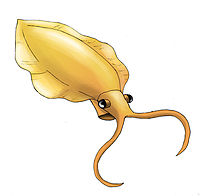
Nectocaris, meaning "swimming shrimp", is a genus of squid-like animal that lived in parts of Canada, Australia, and China during the middle Cambrian. This animal earned its name due to earlier studies interpreting it as a bizarre arthropod. Then in 2011, it was proposed that this species represented an early member of the cephalopod lineage (squids, octopuses, cuttlefish, etc.). This was due to more recent fossil finds showing that it had a more cephalopod-like body plan compared to the traditional arthropod restorations. Since then however, its status as a cephalopod has been questioned on numerous occasions, and is now generally accepted to lie outside of the group, and most likely represents a case of convergent evolution (when two animals share a similar body plan despite not being closely related).[1][2][3][4]
Dinomischus[edit]

Dinomischus, meaning "goblet stalk", is a genus of soft-bodied animal that lived in Canada and China during the middle Cambrian. This animal sat on the seafloor with a long stalk, and was around 20 mm in height. The head was shaped like a cup, and possessed around eighteen short "petal" shaped arms around it. This animal is actually relatively rare, as in the Burgess Shale for example, only around thirteen or so specimens have been discovered at that site. This creature was most likely a filter feeder, using its arms to catch small food particles from the water column. A number of hypotheses have been suggested regarding this creatures taxonomy, including being a relative of various other Cambrian organisms, or potentially being an early echinoderm. In 2019, a study was published that suggested that this animal was a stem-ctenophoran (comb jelly), which seems to suggest early forms lived attached to the seafloor, similar to polyps.[5][6][7][8][9]
Siphusauctum[edit]

Similar in appearance to Dinomischus, Siphusauctum, meaning "large cup", is a genus of stalked animal that lived in Canada and the United States during the middle Cambrian. This animal was also a probable filter feeder, except it used a series of pores on its calyx (head) to actively filter out particles from the water. It most likely grew to around 7.9 inches tall, and fed mainly on microplankton. It has also been suggested to be a stem-ctenophoran, which could suggest a larger grouping of these early, stalked forms.[10][11][8]
Myoscolex[edit]

Myoscolex, meaning "muscle worm", is a genus of early animal that lived in South Australia during the middle Cambrian. This animal is only known from the Emu Bay Shale, which dates to around 517 million years ago. Two main hypotheses have been proposed for this animals taxonomy, one being an annelid worm, while others think it was a stem-arthropod, potentially related to animals like Opabinia. Myoscolex fossils represent some of the earliest known examples of phosphotized muscle tissue.[12][13][14][15]
Chancelloria[edit]

Chancelloria, which was named after Chancellor Peak, is a genus of sponge-like animal that lived in various regions of the world, including the United States, Canada, Iran, and England from the lower to upper Cambrian. This creature had a hollow bag-like body with a soft skin, and was armored with star-shaped calcareous sclerites from which radiated sharp spines. They were (again) a probable filter feeder, attaching themselves to the seafloor, and using their sclerites as a defense system similar to the spines of modern cacti. This animal is the type genus of the Chancelloriida, a somewhat diverse group of sponge-like animals who's taxonomy has been questioned. Some paleontologists classify them as sponges, while others classify them as being related to the halkieriids, which were slug-like stem-mollusks, and some even classify them as an independent group of basal eumetazoans.[16][17][18][19][20]
Vetulicola[edit]


Vetulicola, which means "ancient inhabitant" is a genus of early animal that lived in China during lower Cambrian. These animals most likely lived a nektonic lifestyle, as well as being obligate filter feeders due to the presence of gill slits. They could reach up to 9 cm long, and had slender bodies similar to those of arthropods. A number of species belonging to this genus have been found, showing its successful status in life. This creature is the type genus of the Vetulicolia, a diverse phylum of early animals from the Cambrian. While their taxonomy is still convoluted, it seems that they were early deuterostomes, more specifically, potential chordates related to modern tunicates.[21][22][23][24]
Sarotrocercus[edit]
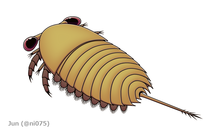
Sarotrocercus, which means "forgotten sweeper" is a genus of small sized arthropod that lived in Canada during the middle Cambrian. When this creature was first discovered in the Burgess Shale in 1981, it was regarded as a nektonic animal, swimming upside down in the water column. This was due to the limited amount of known fossils at the time. More recent studies however have shown more support for a benthic lifestyle for this creature. It was not that large, only reaching around a centimetre or two in length (0.39–0.79 in). Some scientists believe that this creature was a member of the "Crown group Arthropoda", however any other specific classification is still being discussed.[25][26]
Marrella[edit]
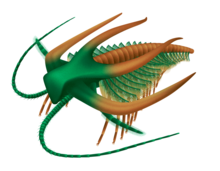
Marrella, which was named after Dr. John Marr, is a genus of extremely common arthropod that lived in Canada and, more rarely, in parts of China during the middle Cambrian. In the Burgess Shale alone, thousands of specimens of this 24.5 millimeter long animal have been found. When it was first discovered in 1912, it was thought to represent a bizarre type of trilobite. This creature swam in the water column in a backstroke motion using multiple pairs of legs and large a set of large spines for stabilization, as well as using its posterior appendages to possibly filter tiny particles of food from the water. Its possible that the front projections of Marrella had a form of diffraction grating patterns, that in life would have resulted in an iridescent sheen (however not all agree with this theory). This creature is the type genus of the marrellomorpha, an enigmatic group of arthropods that lived from the Cambrian to the Lower Devonian periods. The group is mainly characterized by the presence of large head shields with spines, unbranched antennules and a segmented trunk with biramous appendages. Their phylogenetic position is uncertain, various studies have alternatively placed them in the Arachnomorpha as relatives of Artiopoda (trilobites and kin), as related to Mandibulata, or as stem group euarthropods.[27][28][29][30][31][32][7][33]
Chuandianella[edit]

Chuandianella is a genus of enigmatic arthropod that lived in China during the early Cambrian. Up to 30 millimetres (1.2 in) in length, this arthropod possessed a bivalved carapace composed of calcium phosphate. The arthropods head had a pair of stalked eyes. The body had at least 18 segments. The first appendage pair are elongate and antenniform with 10 podomeres with each podomere bearing inward-facing setae, and the second appendage is uniramous and short and has 6 podomeres. This arthropod has been suggested to have actively swam, and filter fed, using its feathery endites to capture small food particles from the water column. This animal was long thought to have been a member of the hymenocarina, a diverse group of Cambrian aged mandibulate arthropods characterized by their bivalved, convex carapaces. In 2022 however, it was found that not only was it not a hymenocarine, but it also wasn't a mandibulate due to the lack of mandibles and maxillae, and was instead considered an "upper stem-group arthropod".[34][35][36]
Cambropachycope[edit]
-
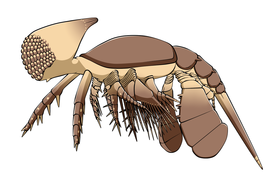 Restoration of Cambropachycope clarksoni
Restoration of Cambropachycope clarksoni -
 Diagrammatic reconstruction of Cambropachycope clarksoni
Diagrammatic reconstruction of Cambropachycope clarksoni
Cambropachycope is a genus of tiny arthropod (1.5 mm (0.059 in) long) that lived in southern Sweden during the upper Cambrian. This animal has a bizarre set of characteristics, including an unusual anterior projection of the head that bears single large compound eye, four pairs of appendages on its head, a mouth that opens on the ventral surface in front of the second pair of appendages, and an abdomen with four segments and two pairs of paddle-shaped appendages, and a telson. Its very unique appearance makes classifying it somewhat of a challenge, with most researchers either suggesting its placement as a pancrustacean or a stem-mandibulate. Living alongside it was Goticaris, a similar looking arthropod that also has a controversial taxonomy. A similar looking arthropod, Goticaris, is also known from the same deposits.[37][38][39]
Kiisortoqia[edit]

Kiisortoqia is a genus of arthropod that lived in Greenland during the lower Cambrian. This creature had a simple head shield, 16 trunk segments (tergites) and a tail plate. In outward appearance the body appears almost elliptical, about twice as long as wide, with the widest point in the front third of the body at the 3rd to 5th tergite. It is believed that Kiisortoqia was a predatory nektonic animal, using its large paddle-like exopods, which were probably suitable for swimming, and using its robust appendages, K. soperi could capture large prey. K. soperi possesses three crown-arthropod homologies: a head shield with three pairs of limbs, plus the appendages; postappendage biramous limbs; and flap-like exopods fringed with setae. An exact position within the arthropods, however, cannot be determined, due to the possible lack of eyes and the ambiguous shape of the tail plate.[40][41]
Bushizheia[edit]
Bushizheia is a genus of arthropod known from lower Cambrian sediments of China. It is known from a single specimen discovered in the Eoredlichia – Wutingaspis trilobite biozone of the Maotianshan Shales. The body of B. yangi consisted of a simple head shield, 8 trunk segments (tergites) and a tail plate. While it had a superficially trilobite-like bodyform, it also possessed large frontal appendages similar to those of radiodonts. It is morphologically similar to Kiisortoqia. Along Kiisortoqia, Bushizheia is currently classed as Euarthropoda incertae sedis, occasionally classed in or close to Artiopoda (trilobites and their relatives).[42][43]
Oelandocaris[edit]

Oelandocaris is a genus of arthropod known from upper Cambrian sediments of Sweden. It is known from six specimens that were discovered in the Orsten lägerstatten in 1983. Oelandocaris has a large head segment with a possible median eye, five tergites, each with a biramous limb pair and a spike on their ends, and a cylindrical tail segment. This animals limbs were large and flattened, suggesting that it was a swimming animal, and presumably planktonic, based on its size. Several suggestions have been made regarding its taxonomy, including being a stem-mandibulate, or possibly a megacheiran.[44][45][46]
Parvibellus[edit]

Parvibellus, from the Latin parvus (small) and bellus (cute),[47] is a genus of small panarthropod from the lower Cambrian of China. It was discovered in 2022 from the famous Chengjiang Biota site. This animal was around 5 mm (0.20 in) in length, and possessed around 11 pairs of trunk swimming flaps, and a ventrally directed circular mouth. These features seem to ally it with the dinocaridid stem-arthropods like the radiodonts and opabiniids.[47] However, a recent paper suggests it may instead be a larval siberiid, and thus a nomen dubium. [48]
Saccorhytus[edit]

Saccorhytus, which means "wrinkle bag", is a genus of early animal that lived in what is now China during the very earliest Cambrian. This strange organism was only around a millimetre (1.3 mm) in size, and possessed a lobular or hemispherical body with a prominent mouth.[49] Around its body were eight openings in the form of truncated cones with radial folds, termed "body cones." Two sets of small circular pores also occur on the body. One set is widely separated and runs parallel to the body cones. Saccorhytus most likely lived a meiofaunal lifestyle, with its body plan suited for an interstitial habitat, such as its thick but flexible cuticle providing protection and allowing it to wriggle through grains of sand. When it was first described in 2017, this creature was thought to represent one of the earliest known deuterostomes (animals like vertebrates who's anus formed before the mouth during embryonic development). However, a study in 2022 found more evidence for this animal to be an early ecdysozoan (animals like arthropods who grow through ecdysis).[50][51]
Echmatocrinus[edit]

Echmatocrinus, which means " lily stalk", is a genus of a cone-shaped animal that lived in Canada during the middle Cambrian. The main body of Echmatocrinus was shaped like a cone, and the head or crown, possessed around seven to ten tentacles. Each tentacle was covered with small extensions, and the cone itself was covered with irregularly arranged mineralised plates. This animal is often compared to echinoderms, like crinoids, however fossils found of Echmatocrinus show that it most likely reproduced via budding, which is usually not found in echinoderms (with the exception of handful of species and larvae).[52][53][54][55]
Herpetogaster[edit]
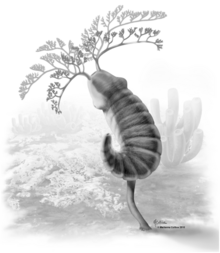
Herpetogaster, which means "stomach creep" is a genus of stalked animal that lived in parts of Canada, China and the United States during the middle Cambrian. Known from over 101 specimens, Herpetogaster possessed a pair of branching tentacles, and a tough, but flexible body that curved helically to the right like a ram's horn and was divided into at least 13 segments. The tentacles might have been controlled by fluid pressure, and individuals could have fed by snaring either small prey or edible particles in the tentacles and bringing the tentacles to the mouth, which was in between the tentacles. This animal is the type genus of the Cambroernida, a clade of Paleozoic animals that might be stem-ambulacrarian deuterostomes, but where they fit in that grouping is still controversial.[56][57][58][59]
Priscansermarinus[edit]

Priscansermarinus is a genus of animal known from the middle Cambrian of Canada. This animal was described in 1981 on the basis of four specimens found in the Burgess Shale. It was originally interpreted as a lepadomorph barnacle, which would make it one of the earliest known crustaceans. However, in recent years some experts including Derek Briggs, a leading authority on the arthropods of the Burgess Shale, have criticized this classification, and some don't even consider Priscansermarinus to be an arthropod.[60][61][7]
Portalia[edit]

Portalia is a genus of animal known from the middle Cambrian of Canada. It was first described in 1918 from fossils found in the Burgess Shale, by Charles Doolittle Walcott, where he initially described it as a holothurian echinoderm. However, some other studies, like Frizzell and Exline (1955) and Madsen (1957), have disputed this claim, the latter of whom believed P. mira to be a kind of primitive sponge. This animal possesses elongated structures resembling tentacles that arose along the length of the body.[62][63][64]
Ordovician[edit]
Keurbosia[edit]
Keurbosia is a genus of enigmatic bilaterian animal known from the upper Ordovician of South Africa. It was discovered in 1998 from the famous Soom shale, and due to it being a nomen nudum, it has yet to be formally described. Keurbosia had a compressed, bilaterally symmetrical segmented body of around 38 cm (15 in) in length, surrounded by pairs of flaps on each segment, imbricating with each other, as well as wider lobe-like appendages of unknown purpose. Some hypotheses have included a possible relation to either arthropods or chordates.[65][66][67]
Tentaculites[edit]

Tentaculites is a problematic genus of shelled invertebrate that first appeared in the lower Ordovician, and survived till the end of the Devonian. Despite its impressive fossil record, this genus is still heavily debated upon in terms of its taxonomy. They had ribbed, cone-shaped shells which range in length from 5 to 20 mm. Some species septate; their embryonic shell, which is retained, forms a small, sometimes spherical, chamber. The taxonomic classification of the tentaculitids is uncertain. Some grouped them with pteropods. They may also be related to other shelled genera of uncertain affinity including the cornulitids, Anticalyptraea, microconchids and the trypanoporids. Their shell microstructure has warranted their comparison with the brachiopods and phoronids, and the possible Ediacaran lophophorate Namacalathus.[68][69][70][71]
Nectocotis[edit]

Nectocotis is a genus of squid-like animal from the upper Ordovician of New York, and a close relative of the Cambrian genus Nectocaris. Like its Cambrian relative, this creature was once considered a cephalopod, but that theory has been disproved many times. The main difference between the two is that Nectocotis seems to possess an internal skeletal element. The discovery of this genus was important because it was thought that animals like Nectocaris went extinct by the end of the Cambrian, so this genus expands the temporal range of its group by dozens of millions of years.[72][73][4]
Silurian[edit]
Parioscorpio[edit]
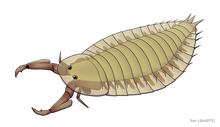
Parioscorpio, which means progenitor scorpion, is a genus of arthropod that lived in the lower Silurian of Wisconsin. This creatures body was around 1.6–4.5 cm (0.63–1.77 in) long, and is characterized by a trapezoidal head with a pair of eyes located antero-medially, a pair of enlarged raptorial appendages, and a another pair of small appendages. Central to the head was a mouth-covering hypostome and a pair of muscular blocks articulated to the raptorial appendages. The trunk is composed of 14 segments. This creature has had an interesting taxonomic history, first being called a crustacean in 1985, a primitive scorpion in 2020, an enigmatic arthropod in 2021, a potential trilobite relative that same year, and in 2023 as a problematic basal euarthropod. [74][75][76][77][78]
Waukesha Butterfly Animal[edit]
Another denizen of lower Silurian Wisconsin, The "Waukesha Butterfly Animal" is an unnamed problematic arthropod coming from the same sediments as Parioscorpio. This animal was first discovered in 1985 and was thought of as a potential phyllocarid relative. This animal gets its nickname due to its bivalved carapace somewhat resembling the wings and body of butterflies (which it is not related too). Although most specimens are small, some isolated carapaces have been found reaching around 20 centimeters (7.8 inches) in width.[79][80][78]
Enalikter[edit]

Enalikter, which means "scourger of the sea", is a genus of elongate, vermiform arthropod from the middle Silurian of the UK. This animal was described in 2014 based on fossils found in the Herefordshire Lagerstätte, and possessed a 2.44 cm (0.96 in) long body with a subrectangular head shield with unpaired antenna and three pairs of appendages, twelve trunk segments that lack tergites, and an egg-shaped telson with two pairs of blade-like processes. When it was first described, Enalikter was thought to represent a late surviving genus of megacheiran (a group of predatory arthropods from the Cambrian often nicknamed "great appendage arthropods", but was re-analyzed later on, and was found to be an annelid worm. However, it has since been re-described as an arthropod, however not all agree with the megacheiran hypothesis. Together, it along with another enigmatic arthropod, Bundenbachiellus from the lower Devonian of Germany, form the family Enaliktidae.[81][82][83][84]
Plumalina[edit]

Plumalina is a genus of soft bodied fossils known from various strata of Silurian and Devonian age. They appear as small, feather-like fossils that somewhat resemble alga. Some scientists assign this organism to the cnidaria group, more specifically the hydrozoans or the gorgonarians, but its taxonomy has not been fully resolved.[85][86]
Devonian[edit]
Palaeospondylus[edit]
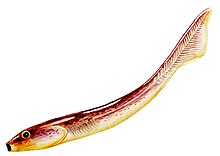
Palaeospondylus, which means "early vertebrate" is a genus of basal vertebrate that lived in Scotland during the middle Devonian. This creature was around 6 centimetres (2 in) in length, and possessed a skull that consisted of hardened cartilage. The taxonomy of this fossil has puzzled scientists since its discovery in 1890, and many taxonomies have been suggested. In 2004, researchers proposed that Palaeospondylus was a larval lungfish. Previously, it had been classified as a larval tetrapod, an unarmored placoderm, an agnathan, an early stem hagfish, a chimera, and a 2017 study suggested that it was a stem chondrichthyan. In 2022, it was suggested to have been an early stem tetrapod that sat between the genera Eusthenopteron and Panderichthys.[87][88][89]
Wingertshellicus[edit]
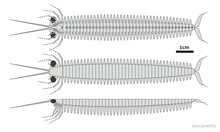
Wingertshellicus is a genus of elongate arthropod that lived in the lower Devonian of Germany. It is only known from the Hunsrück Slate, one of the few Devonian marine fossil sites that preserves soft tissue. Measuring around 7.5 centimetres or 3.0 inches long, this arthropod had a head that possessed a pair of large stalked compound eyes and 7 pairs of appendages, and a trunk made up of 40 segments (somites), which carried a pair of biramous appendages with enlarged basipod (basal segment), flap-like exopods (outer branch) and slender endopods (inner branch). the trunk terminated by a pair of fluke-like appendages with flagellate structures. It was originally described in 2001 as some kind of crustaceanomorph, but due to the lack of mandibles and other taxonomic definitive characters, Wingertshellicus is not even assignable to the Mandibulata (a clade composed of myriapods, crustaceans and hexapods) nor any known arthropod subgroups.[90][91][92]
Rhyniognatha[edit]

Rhyniognatha is a genus of arthropod that lived in Scotland during the lower Devonian. This animal is known from the Rhynie Chert, a Lagerstätte famous for preserving one of the oldest known terrestrial ecosystems. In 2004, fossils of R. hirsti were reanalyzed, and found that it was an early insect, and that it potentially had wings. This would make this genus very important, as its age would make it the oldest confirmed insect. However, over the years, several other studies have contested this claim, with a 2017 study for instance proposing that it was actually a myriapodan, specifically a scutigeromorph centipede, however the study was unable to disprove an insect identity completely.[93][94][95]
Plesioselachus[edit]

Plesioselachus, which means "near shark", is a genus of chondrichthyean (cartilaginous fish) that lived in South Africa during the upper Devonian. This genus is only known from a single incomplete articulated skeleton and some isolated remains, it is characterized by having a long dorsal spine with length about one third of body length. Some specimens, such as a 22.5 centimeter (8.9 in) long isolated fin spine, show Plesioselachus could grow larger than the holotype specimen, around a 1 meter (3.3 ft) in length. It was originally classified as an elasmobranch (the grouping including sharks, rays, and their relatives) however the lack of remains make classifying it further difficult.[96][97][98]
Mushia[edit]

Another denizen of the Gogo Formation, 'Mushia" is the nickname given to an unnamed arthropod of uncertain classification. The animal has received this nickname due to the squashed appearance of the fossils. Although the creature seems to lack a carapace, it has been found to be some kind of crustacean through chemotaxonomy, although what kind is still up for debate.[99]
Carboniferous[edit]
Tullimonstrum[edit]
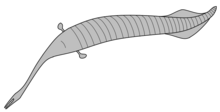


Tullimonstrum, also known as the "Tully monster", is a genus of soft bodied animal that lived in coastal environments of northern Illinois during the upper Carboniferous. Tullimonstrum is only known from the Mazon Creek fossil beds, a Lagerstätte famous for its fossil preservation inside of numerous ironstone nodules. It probably reached lengths of up to 35 centimetres (14 in), and had a mostly cigar shaped body, with a triangular tail fin, two long stalked eyes, and a proboscis tipped with a mouth-like appendage. Based on the fossils, it seems this creature was a nektonic carnivore that hunted in the ocean’s water column. This animal was first described back in 1966, but since then has been the center of one of the longest running mysteries in paleontological history. Its classification has been the subject of controversy, and interpretations of the fossil have likened it to molluscs, arthropods, worms, tunicates, and vertebrates.[100][101][102][103][104]
Typhloesus[edit]

Typhloesus, sometimes referred to as the "alien goldfish" by some studies, is a genus of enigmatic invertebrate that lived in Montana during the middle Carboniferous. It is only known from the Bear Gulch Limestone, a sedimentary deposit famous for preserving large numbers of cartilaginous fish. The animal had a fusiform body, with a maximum length of 90 mm. At the posterior or backside of the animal is a caudal fin, which was supported by two sets of orthogonal fin rays. The internal anatomy consists of a foregut and a midgut. The gut lacks a midsection and an anus. Beneath the midgut is a disc-shaped organ, tentatively called a ferrodiscus; the purpose of this organ is unknown, however it has a high concentration of iron. When Typhloesus was first described back in 1973, it was thought to have been the first discovered body fossil of a conodont, a group of eel-like agnathan fish. This was based on the finding of large amounts of conodont teeth in association with fossils of Typhloesus. However, that theory was proven false when it turned out the teeth were actually in the gut contents of the Typhloesus, meaning that while it wasn't a conodont, they were a part of its diet. The animals taxonomy would be shrouded in mystery for over 30 years until in September 2022, when a new paper published revealed several potential mollusk-like features of the animal, including a radula-like appendage.[105][106]
Pohlsepia[edit]
Pohlsepia, which was named after its discoverer James Pohl, is a genus of invertebrate animal that lived in northern Illinois during the upper Carboniferous. It was around 3.5 cm (1.4 in) long, and had a "sack-like" body. When Pohlsepia was first described from the Mazon Creek Fossil Beds in 2000, it was assigned to the Cirrina, a suborder of octopuses, which would not only make Pohlsepia a cephalopod, but would also make it one of the most basal known octopuses. However, many other researchers have disagreed over the years, citing the lack of an internal structure (a key feature of cirrate octopods). In 2022, it was considered that this creature was not a cephalopod, or a mollusk in general. It lacking a shell is a highly unlikely combination in a Carboniferous aged cephalopod. In addition, its appendages lack hooks, suckers, cirri, an arm web, and the characteristic 8/10 arm count. There is no evidence of a beak, unambiguous ink sac, nor a radula. The bulbous body outline and presence of appendages show a more likely affinity as a cnidarian.[107][108][109][110]
Etacystis[edit]

Etacystis, commonly known as the "H-animal" or "aitch", is a genus of invertebrate animal that lived in northern Illinois during the upper Carboniferous. Found in the Mazon Creek Fossil Beds in 1976, this animal gets its genus name from its shape, being roughly similar in shape to the letter "H", and Eta is the Greek letter "H" while cystis, from the Greek kystis, means sac or bladder, referring to the organism's sac-like body plan. It was around 11-15 cm in life and had a stolon-like structure from which a peduncle arises at approximate right angles. It was most likely a colonial organism that continued to grow throughout its lifetime, explaining the wide variation in specimen sizes found. The exact shape of the main sac varies significantly from specimen to specimen, from lobe-shaped to heart-shaped and others. Because of insufficient evidence, this animal has not been aligned with any known phylum, however affinities with hemichordates like pterobranches, or cnidarians like siphonophores have been suggested over the years.[111][112][113]
Listracanthus[edit]

Listracanthus is a genus of chondrichthyean fish that lived in various areas of the world from the upper Carboniferous to the lower Triassic. This genus is distinct from other chondrichthyeans because of the large number of feather-like dermal denticles that adorned this animals dorsal side. The denticles had a large main spine, from which secondary spines emanated from the sides, like the barbs of a feather or a comb. The appearance of these fish is largely unknown. However, author and illustrator Ray Troll mentions in his book, Sharkabet, about how paleontologist Rainer Zangerl once discovered a large shale slab containing a long, eel-like fish covered in long, spine-like denticles characteristic of the genus, only to have it dry out and crumble into dust. It, alongside its close relative Acanthorhachis, are most likely members of the elasmobranchii subclass, however their exact position is still unresolved.[114][115][116]
Delphyodontos[edit]

Delphyodontos, which means "womb tooth", is a genus of chondrichthyean fish known from the Bear Gulch Limestone site in Montana, which dates to the middle Carboniferous. This genus is unique because the only known fossils of it represent either recently born young, or aborted fetuses. Because of this, the adult form of Delphyodontos is not known, and there are a number of fish from Bear Gulch that could represent it. Despite this, most scientists agree that this fish belongs to the holocephali subclass, meaning its more closer related to modern day chimeras (rabbit fish) then to sharks or rays. However, without the adult stage being found, determining its exact placement is more or less impossible. Sharp teeth and fecal matter in the fossils suggests that Delphyodontos practiced intrauterine cannibalism, like some modern chondrichthyeans, such as sand tiger sharks.[117][118]
Bandringa[edit]

Bandringa is a genus of chondrichthyean fish that lived in northern Illinois and Pennsylvania during the upper Carboniferous period. Although this animal superficially resembles paddlefish, studies have found that it sat in the elasmobranchii subclass alongside sharks, rays, and their relatives. This animals most distinctive feature was a long, paddle-shaped upper snout that took up half of the fishes total body length. Bandringa most likely used its rostrum to search for prey in murky water, and most likely fed via suction feeding. Preserved gut contents include articulated arthropods. The holotype specimen had length about 11 cm (4.3 in), but the largest known adult specimen, PU19814 is estimated to be more than five times larger than the type specimen. This fish lived a lifestyle somewhat similar to that of Salmon, where the young would live in marine environments, but would later grow up, and move to freshwater areas. Although Bandringa was originally described as a member of the Ctenacanthiformes, its relationships to other elasmobranchs is currently unclear.[119][120][121]
References[edit]
- ^ Kröger, Björn; Vinther, Jakob; Fuchs, Dirk (August 2011). "Cephalopod origin and evolution: A congruent picture emerging from fossils, development and molecules". BioEssays. 33 (8): 602–613. doi:10.1002/bies.201100001. PMID 21681989. S2CID 2767810.
- ^ Smith, M.R. (2013). "Nectocaridid ecology, diversity and affinity: Early origin of a cephalopod-like body plan". Paleobiology. 39 (2): 291–321. Bibcode:2013Pbio...39..297S. doi:10.1666/12029. S2CID 85744624.
- ^ Conway Morris, S. (1976). "Nectocaris pteryx, a new organism from the Middle Cambrian Burgess Shale of British Columbia". Neues Jahrbuch für Geologie und Paläontologie, Monatshefte. 12: 703–713.
- ^ a b Pohle, Alexander; Kröger, Björn; Warnock, Rachel C. M.; King, Andy H.; Evans, David H.; Aubrechtová, Martina; Cichowolski, Marcela; Fang, Xiang; Klug, Christian (December 2022). "Early cephalopod evolution clarified through Bayesian phylogenetic inference". BMC Biology. 20 (1): 88. doi:10.1186/s12915-022-01284-5. ISSN 1741-7007. PMC 9008929. PMID 35421982.
- ^ Hou, X.-G. (2004). The Cambrian Fossils of Chengjiang, China : The Flowering of Early Animal Life. Blackwell Publishing. ISBN 978-1-4051-0673-3.
- ^ Morris, S.C. (1977). "A new entoproct-like organism from the Burgess Shale of British Columbia" (PDF). Palaeontology. 20 (4): 833–845.
- ^ a b c Caron, Jean-Bernard; Jackson, Donald A. (October 2006). "Taphonomy of the Greater Phyllopod Bed community, Burgess Shale". PALAIOS. 21 (5): 451–65. Bibcode:2006Palai..21..451C. doi:10.2110/palo.2003.P05-070R. JSTOR 20173022. S2CID 53646959.
- ^ a b Zhao, Yang; Hou, Xian-guang; Cong, Pei-yun (2023-01-01). "Tentacular nature of the 'column' of the Cambrian diploblastic Xianguangia sinica". Journal of Systematic Palaeontology. 21 (1). Bibcode:2023JSPal..2115787Z. doi:10.1080/14772019.2023.2215787. ISSN 1477-2019. S2CID 259400853.
- ^ Chen, J.Y.; Zhou, G.Q. (1997). "Biology of the Chengjiang fauna". Bull. Natl. Mus. Nat. Sci. 10: 11–105.
- ^ Julien Kimmig, Luke C. Strotz & Bruce S. Lieberman (2017). "The stalked filter feeder Siphusauctum lloydguntheri n. sp. from the middle Cambrian (Series 3, Stage 5) Spence Shale of Utah: its biological affinities and taphonomy". Journal of Paleontology. 91 (5): 902–910. Bibcode:2017JPal...91..902K. doi:10.1017/jpa.2017.57.
- ^ Lorna J. O'Brien & Jean-Bernard Caron (2012). "A new stalked filter-feeder from the Middle Cambrian Burgess Shale, British Columbia, Canada". PLoS ONE. 7 (1): e29233. Bibcode:2012PLoSO...729233O. doi:10.1371/journal.pone.0029233. PMC 3261148. PMID 22279532.
- ^ Nelson R Cabej (2019). Epigenetic Mechanisms of the Cambrian Explosion. Elsevier Science. p. 153. ISBN 9780128143124.
- ^ Dzik, Jerzy (January 2004). "Anatomy and relationships of the Early Cambrian worm Myoscolex". Zoologica Scripta. 33 (1): 57–69. doi:10.1111/j.1463-6409.2004.00136.x. ISSN 0300-3256. S2CID 85216629.
- ^ Briggs, D. E. G.; Nedin, C. (1997). "The Taphonomy and Affinities of the Problematic Fossil Myoscolex from the Lower Cambrian Emu Bay Shale of South Australia". Journal of Paleontology. 71 (1): 22–32. Bibcode:1997JPal...71...22B. doi:10.1017/S0022336000038919. JSTOR 1306537. S2CID 131851540.
- ^ J. Paterson, J. Jago, J. Gehling, D. García‐Bellido, G. Edgecombe, Msy Lee (2008). "Early Cambrian Arthropods from the Emu Bay Shale Lagerstätte, South Australia" (PDF). Advances in Trilobite Research.
{{cite journal}}: CS1 maint: multiple names: authors list (link)"Archival copy" (PDF). Archived from the original (PDF) on November 1, 2018. - ^ Bengtson, Stefan; Collins, Desmond (August 2009). "Burgess Shale Chancelloriids – A Prickly Problem" (PDF). In Smith, Martin R.; O'Brien, Lorna J.; Caron, Jean-Bernard (eds.). Abstract Volume. International Conference on the Cambrian Explosion (Walcott 2009). Toronto, Ontario, Canada: The Burgess Shale Consortium (published 31 July 2009). ISBN 978-0-9812885-1-2.
- ^ Yun, Hao; Zhang, Xingliang; Brock, Glenn A.; Li, Luoyang; Li, Guoxiang (2021-02-05). "Biomineralization of the Cambrian chancelloriids". Geology. 49 (6): 623–628. Bibcode:2021Geo....49..623Y. doi:10.1130/g48428.1. ISSN 0091-7613. S2CID 234069516.
- ^ Bengtson, S; Collins, D (2015). "Chancelloriids of the Cambrian Burgess Shale". Palaeontologia Electronica. 18 (1): 1–67. doi:10.26879/498. ISSN 1094-8074.
- ^ Bengtson, S. (2002). "Origins and early evolution of predation". In Kowalewski, M.; Kelley, P.H. (eds.). The fossil record of predation. The Paleontological Society Papers 8. The Paleontological Society. pp. 289–317.
- ^ Janussen, D.; Steiner, M. & Zhu, M.-Y. (2002). "New Well-preserved Scleritomes of Chancelloridae from the Early Cambrian Yuanshan Formation (Chengjiang, China) and the Middle Cambrian Wheeler Shale (Utah, USA) and paleobiological implications". Journal of Paleontology. 76 (4): 596–606. doi:10.1666/0022-3360(2002)076<0596:NWPSOC>2.0.CO;2. S2CID 129127213. Retrieved 2008-08-04. Free full text without images at Janussen, Dorte (2002). "(as above)". Journal of Paleontology. Archived from the original on 2008-12-10. Retrieved 2008-08-04.
- ^ Ou, Qiang; Morris, Simon Conway; Han, Jian; Zhang, Zhifei; Liu, Jianni; Chen, Ailin; Zhang, Xingliang; Shu, Degan (2012). "Evidence for gill slits and a pharynx in Cambrian vetulicolians: implications for the early evolution of deuterostomes". BMC Biology. 10 (1): 81. doi:10.1186/1741-7007-10-81. PMC 3517509. PMID 23031545.
- ^ Shu, D. G.; Morris, S. C.; Han, J.; Chen, L.; Zhang, X. L.; Zhang, Z. F.; Liu, H. Q.; Li, Y.; Liu, J. N. (2001-11-22). "Primitive deuterostomes from the Chengjiang Lagerstätte (Lower Cambrian, China)". Nature. 414 (6862): 419–424. Bibcode:2001Natur.414..419S. doi:10.1038/35106514. ISSN 0028-0836. PMID 11719797. S2CID 4345484.
- ^ García-Bellido, Diego C; Paterson, John R (2014). "A new vetulicolian from Australia and its bearing on the chordate affinities of an enigmatic Cambrian group". BMC Evolutionary Biology. 14 (1): 214. Bibcode:2014BMCEE..14..214G. doi:10.1186/s12862-014-0214-z. PMC 4203957. PMID 25273382.
- ^ Aldridge, Richard J.; Hou, Xian-guang; Siveter, David J.; Siveter, Derek J.; Sarah E., Gabbott (2007). "The systematics and phylogenetic relationships of vetulicolians". Palaeontology. 50 (1): 131–168. Bibcode:2007Palgy..50..131A. doi:10.1111/j.1475-4983.2006.00606.x. S2CID 85722738.
- ^ Haug, J.T.; Maas, A.; Haug, C.; Waloszek, D. (2011). "Sarotrocercus oblitus – Small arthropod with great impact on the understanding of arthropod evolution?". Bulletin of Geosciences: 725–7??. doi:10.3140/bull.geosci.1283.
- ^ Whittington, H.B. (1981). "Rare Arthropods from the Burgess Shale, Middle Cambrian, British Columbia". Philosophical Transactions of the Royal Society of London. Series B, Biological Sciences. 292 (1060). The Royal Society: 329–357. Bibcode:1981RSPTB.292..329W. doi:10.1098/rstb.1981.0033. JSTOR 2395674.
- ^ Moysiuk, Joseph; Izquierdo-López, Alejandro; Kampouris, George E.; Caron, Jean-Bernard (July 2022). "A new marrellomorph arthropod from southern Ontario: a rare case of soft-tissue preservation on a Late Ordovician open marine shelf". Journal of Paleontology. 96 (4): 859–874. Bibcode:2022JPal...96..859M. doi:10.1017/jpa.2022.11. ISSN 0022-3360.
- ^ Rak, Š. P. N. (2011). "A revision of the Late Ordovician marellomorph arthropod Furca bohemica from Czech Republic". Acta Palaeontologica Polonica. doi:10.4202/app.2011.0038.
- ^ Whittington, H. B. (1971). "Redescription of Marrella splendens (Trilobitoidea) from the Burgess Shale, Middle Cambrian, British Columbia" (PDF). Bulletin – Geological Survey of Canada. 209. Geological Survey of Canada: 1–24.
- ^ García-Bellido, Diego & Collins, Desmond. (2006). A new study of Marrella splendens (Arthropoda, Marrellomorpha) from the Middle Cambrian Burgess Shale, British Columbia, Canada. Canadian Journal of Earth Sciences. 43. 721–742. 10.1139/e06-012.
- ^ Parker, A. R. (1998). "Colour in Burgess Shale animals and the effect of light on evolution in the Cambrian". Proceedings of the Royal Society B: Biological Sciences. 265 (1400): 967–972. doi:10.1098/rspb.1998.0385. PMC 1689164.
- ^ Smith, Martin R. (January 2014). Lane, Phil (ed.). "Ontogeny, morphology and taxonomy of the soft-bodied Cambrian 'mollusc' Wiwaxia". Palaeontology. 57 (1): 215–229. Bibcode:2014Palgy..57..215S. doi:10.1111/pala.12063. S2CID 84616434.
The full width of each sclerite [of Wiwaxia] is striated by finely spaced longitudinal lineations. Parker (1998) argued that these were superficial – although they are not visible on surfaces imaged under SEM and do not exhibit interference under transmitted light, so might be better interpreted as internal channels indicating microvillar secretion.
- ^ Liu, Qing (May 2013). "The First Discovery of Marrella (Arthropoda, Marrellomorpha) from the Balang Formation (Cambrian Series 2) in Hunan, China". Journal of Paleontology. 87 (3): 391–394. Bibcode:2013JPal...87..391L. doi:10.1666/12-118.1. ISSN 0022-3360. S2CID 129018525.
- ^ Zhai, Dayou; Williams, Mark; Siveter, David J.; Siveter, Derek J.; Harvey, Thomas H. P.; Sansom, Robert S.; Mai, Huijuan; Zhou, Runqing; Hou, Xianguang (2022-02-22). "Chuandianella ovata: An early Cambrian stem euarthropod with feather-like appendages". Palaeontologia Electronica. 25 (1): 1–22. doi:10.26879/1172. ISSN 1094-8074. S2CID 247123967.
- ^ Hu-Qin Liu & De-Gan Shu (2004). "澄江化石库中川滇虫属化石的新信息" [New information on Chuandianella from the Lower Cambrian Chengjiang Fauna, Yunnan, China]. Journal of Northwest University (Natural Science Edition) (in Chinese). 34 (4): 453–456.
- ^ "Chuandianella". Paleobiology Database. Retrieved February 16, 2012.
- ^ Waloszek, Dieter; Müller, Klaus (1990-10-01). "Upper Cambrian stem-lineage crustaceans and their bearing upon the monophyly of Crustacea and the position of Agnostus". Lethaia. 23: 409–427. doi:10.1111/j.1502-3931.1990.tb01373.x.
- ^ Parker, Andrew R.; Schoenemann, Brigitte; Haug, Joachim T.; Waloszek, Dieter (2013-08-01). "An Unusual Cornea from a Well Preserved ('Orsten') Cambrian Compound Eye". Paleontological Research. 17 (3): 251–261. doi:10.2517/1342-8144-17.3.251. ISSN 1342-8144. S2CID 129851449.
- ^ Edgecombe, Gregory D. (2017-09-01). "Inferring Arthropod Phylogeny: Fossils and their Interaction with Other Data Sources". Integrative and Comparative Biology. 57 (3): 467–476. doi:10.1093/icb/icx061. ISSN 1540-7063. PMID 28957518.
- ^ Martin Stein (2010). "A new arthropod from the Early Cambrian of North Greenland, with a 'great appendage'-like antennula". Zoological Journal of the Linnean Society. 158 (3): 477–500. doi:10.1111/j.1096-3642.2009.00562.x.
- ^ Martin Stein & Paul A. Selden (2012). "A restudy of the Burgess Shale (Cambrian) arthropod Emeraldella brocki and reassessment of its affinities". Journal of Systematic Palaeontology. 10 (2): 361–383. Bibcode:2012JSPal..10..361S. doi:10.1080/14772019.2011.566634. S2CID 55018927.
- ^ O’Flynn, Robert J.; Audo, Denis; Williams, Mark; Zhai, Dayou; Chen, Hong; Liu, Yu (5 August 2020). "A new euarthropod with 'great appendage'-like frontal head limbs from the Chengjiang Lagerstätte, Southwest China". Palaeontologia Electronica. 23 (2): 1–23. doi:10.26879/1069. ISSN 1094-8074. S2CID 221565910.
- ^ Berks, H. O.; Lunde Nielsen, M.; Flannery‐Sutherland, J.; Thorshøj Nielsen, A.; Park, T.‐Y. S.; Vinther, J. (2023). "A possibly deep branching artiopodan arthropod from the lower Cambrian Sirius Passet Lagerstätte (North Greenland)". Papers in Palaeontology. 9 (3). Bibcode:2023PPal....9E1495B. doi:10.1002/spp2.1495.
- ^ "Oelandocaris oelandica and the stem lineage of Crustacea". researchgate.net.
- ^ Aria, Cédric; Caron, Jean-Bernard (2017). "Burgess Shale fossils illustrate the origin of the mandibulate body plan". Nature. 545 (7652): 89–92. Bibcode:2017Natur.545...89A. doi:10.1038/nature22080. PMID 28445464. S2CID 4454526.
- ^ Müller, Klaus J. (1983). "Crustacea with preserved soft parts from the Upper Cambrian of Sweden". Lethaia. 16 (2): 93–109. doi:10.1111/j.1502-3931.1983.tb01704.x.
- ^ a b Liu, Jianni; Dunlop, Jason A.; Steiner, Michael; Shu, Degan (2022-07-22). "A Cambrian fossil from the Chengjiang fauna sharing characteristics with gilled lobopodians, opabiniids and radiodonts". Frontiers in Earth Science. 10: 861934. doi:10.3389/feart.2022.861934. ISSN 2296-6463.
- ^ McCall, Christian (13 December 2023). "A large pelagic lobopodian from the Cambrian Pioche Shale of Nevada". Journal of Paleontology. doi:10.1017/jpa.2023.63. Retrieved 13 December 2023.
- ^ Han, Jian; Morris, Simon Conway; Ou, Qiang; Shu, Degan; Huang, Hai (2017). "Meiofaunal deuterostomes from the basal Cambrian of Shaanxi (China)". Nature. 542 (7640): 228–231. Bibcode:2017Natur.542..228H. doi:10.1038/nature21072. ISSN 0028-0836. PMID 28135722. S2CID 353780.
- ^ Yunhuan Liu; Emily Carlisle; Huaqiao Zhang; Ben Yang; Michael Steiner; Tiequan Shao; Baichuan Duan; Federica Marone; Shuhai Xiao; Philip C. J. Donoghue (2022). "Saccorhytus is an early ecdysozoan and not the earliest deuterostome". Nature. 609 (7927): 541–546. Bibcode:2022Natur.609..541L. doi:10.1038/s41586-022-05107-z. PMID 35978194. S2CID 251646316.
- ^ Han, Jian; Morris, Simon Conway; Ou, Qiang; Shu, Degan; Huang, Hai (2017). "Meiofaunal deuterostomes from the basal Cambrian of Shaanxi (China)". Nature. 542 (7640): 228–231. Bibcode:2017Natur.542..228H. doi:10.1038/nature21072. ISSN 0028-0836. PMID 28135722. S2CID 353780.
- ^ Babcock, L. E.; Ausich, W. I. (2000). "Echmatocrinus, a Burgess Shale animal reconsidered". Lethaia. 33 (2): 92–95. Bibcode:2000Letha..33...92A. doi:10.1080/00241160050150221.
- ^ Sprinkle, James; Collins, Desmond (29 March 2007). "Revision of Echmatocrinus from the Middle Cambrian Burgess Shale of British Columbia". Lethaia. 31 (4): 269–282. doi:10.1111/j.1502-3931.1998.tb00517.x.
- ^ Yamaguchi, M.; J. S. Lucas (1984). "Natural parthenogenesis, larval and juvenile development, and geographical distribution of the coral reef asteroid Ophidiaster granifer". Marine Biology. 83 (1): 33–42. Bibcode:1984MarBi..83...33Y. doi:10.1007/BF00393083. S2CID 84475593.
- ^ McGovern, Tamara M. (5 April 2002). "Patterns of sexual and asexual reproduction in the brittle star Ophiactis savignyi in the Florida Keys" (PDF). Marine Ecology Progress Series. 230: 119–126. Bibcode:2002MEPS..230..119M. doi:10.3354/meps230119. Archived (PDF) from the original on 2022-10-09.
- ^ Canada, Royal Ontario Museum and Parks (2011-06-10). "The Burgess Shale". burgess-shale.rom.on.ca. Retrieved 2018-10-27.
- ^ Caron, Jean-Bernard; Conway Morris, Simon; Shu, Degan (2010-03-08). "Tentaculate Fossils from the Cambrian of Canada (British Columbia) and China (Yunnan) Interpreted as Primitive Deuterostomes". PLOS ONE. 5 (3): e9586. Bibcode:2010PLoSO...5.9586C. doi:10.1371/journal.pone.0009586. ISSN 1932-6203. PMC 2833208. PMID 20221405.
- ^ Kimmig, Julien; Meyer, Ronald C.; Lieberman, Bruce S. (2019-01-01). "Herpetogaster from the early Cambrian of Nevada (Series 2, Stage 4) and its implications for the evolution of deuterostomes". Geological Magazine. 156 (1): 172–178. Bibcode:2019GeoM..156..172K. doi:10.1017/S0016756818000389. ISSN 1469-5081. S2CID 134642027.
- ^ Yang, Xianfeng; Kimmig, Julien; Lieberman, Bruce S.; Peng, Shanchi (2020-08-28). "A new species of the deuterostome Herpetogaster from the early Cambrian Chengjiang biota of South China". The Science of Nature. 107 (5): 37. Bibcode:2020SciNa.107...37Y. doi:10.1007/s00114-020-01695-w. ISSN 1432-1904. PMC 7544619. PMID 32857275.
- ^ Desmond Collins & David M. Rudkin (1981). "Priscansermarinus barnetti, a probable lepadomorph barnacle from the Middle Cambrian Burgess Shale of British Columbia". Journal of Paleontology. 55 (5): 1006–1015. JSTOR 1304526.
- ^ "DServe Archive Catalog Show". collections.royalsociety.org. Retrieved 2018-10-27.
- ^ Hoffman, Antoni; Niteki, Matthew H., eds. (1986). "Problematic Fossil Taxa". Oxford Monographs on Geology and Geophysics. 5. Oxford University Press: 174–175. ISBN 0-19-503992-0.
- ^ Madsen, Fritz Jensenius (1957). "On Walcott's supposed Cambrian holothurians". Journal of Paleontology. 31 (1). The Paleontological Society: 281–282. JSTOR i255711.
- ^ Durham, J. Wyatt (1974). "Systematic Position of Eldonia ludwigi Walcott". Journal of Paleontology. 48 (4). The Paleontological Society: 750–755. JSTOR 1303225.
- ^ Gabbott, Sarah E.; Browning, Claire; Theron, Johannes N.; Whittle, Rowan J. (2017). "The late Ordovician Soom Shale Lagerstätte: an extraordinary post-glacial fossil and sedimentary record" (PDF). Journal of the Geological Society. 174 (1): 1–9. Bibcode:2017JGSoc.174....1G. doi:10.1144/jgs2016-076. ISSN 0016-7649.
- ^ Male, Alan (2012). "Pictures of new knowledge: a dilemma of fact or fantasy". Proceedings of the 2nd International Conference of Art, Illustration and Visual Culture in Infant and Primary Education.
- ^ Aldridge, R.J., Gabbott, S.E. & Theron, J.N. 2001. The Soom Shale. In: Briggs, D.E.G. & Crowther, P.R. (eds) Palaeobiology II. Blackwell, Oxford, 340–342.
- ^ Towe, K. M. (1978). "Tentaculites: Evidence for a Brachiopod Affinity?". Science. 201 (4356): 626–628. Bibcode:1978Sci...201..626T. doi:10.1126/science.201.4356.626. PMID 17794124. S2CID 22806221.
- ^ Filipiak, P.; Jarzynka, A. (2009). "Organic Remains of Tentaculitids: New Evidence from Upper Devonian of Poland". Acta Palaeontologica Polonica. 54: 111–116. doi:10.4202/app.2009.0111.
- ^ Vinn, O. (2010). "Adaptive strategies in the evolution of encrusting tentaculitoid tubeworms". Palaeogeography, Palaeoclimatology, Palaeoecology. 292 (1–2): 211–221. Bibcode:2010PPP...292..211V. doi:10.1016/j.palaeo.2010.03.046. Retrieved 2014-01-11.
- ^ Vinn, O.; Zatoń, M. (2012). "Phenetic phylogenetics of tentaculitoids — extinct problematic calcareous tube-forming organisms". GFF. 134 (2): 145–156. Bibcode:2012GFF...134..145V. doi:10.1080/11035897.2012.669788. S2CID 83591938. Retrieved 2014-06-11.
- ^ Smith, Martin R. (2020). "An Ordovician nectocaridid hints at an endocochleate origin of Cephalopoda" (PDF). Journal of Paleontology. 94 (1): 64–69. Bibcode:2020JPal...94...64S. doi:10.1017/jpa.2019.57. S2CID 201208912.
- ^ Smith, M. R. (2019). "High resolution photographs of Nectocotis rusmithi". Figshare (Data Set). doi:10.6084/m9.figshare.c.3953191.
- ^ Mikulic, Donald G.; Briggs, Derek E. G.; Kluessendorf, Joanne (1985). "A Silurian Soft-Bodied Biota". Science. 228 (4700): 715–717. Bibcode:1985Sci...228..715M. doi:10.1126/science.228.4700.715. ISSN 0036-8075. JSTOR 1694543. PMID 17841003. S2CID 36327898.
- ^ Braddy, S.J.; Dunlop, J.A. (2021). "A sting in the tale of Parioscorpio venator from the Silurian of Wisconsin: is it a cheloniellid arthropod?". Lethaia. 54 (1): 1–7. Bibcode:2021Letha..54..603B. doi:10.1111/let.12457. S2CID 245285654.
- ^ Wendruff, Andrew J.; Babcock, Loren E.; Wirkner, Christian S.; Kluessendorf, Joanne; Mikulic, Donald G. (December 2020). "A Silurian ancestral scorpion with fossilised internal anatomy illustrating a pathway to arachnid terrestrialisation". Scientific Reports. 10 (1): 14. Bibcode:2020NatSR..10...14W. doi:10.1038/s41598-019-56010-z. ISSN 2045-2322. PMC 6965631. PMID 31949185.
- ^ Van Roy, Peter; Rak, Štěpán; Budil, Petr; Fatka, Oldřich (2022-06-13). "Redescription of the cheloniellid euarthropod Triopus draboviensis from the Upper Ordovician of Bohemia, with comments on the affinities of Parioscorpio venator". Geological Magazine. 159 (9): 1471–1489. Bibcode:2022GeoM..159.1471V. doi:10.1017/s0016756822000292. ISSN 0016-7568. S2CID 249652930.
- ^ a b Gass, Kenneth C.; Braddy, Simon J. (2023). "The Waukesha Biota: a wonderful window into early Silurian life". Geology Today. 39 (5): 169–176. Bibcode:2023GeolT..39..169G. doi:10.1111/gto.12447. ISSN 0266-6979. S2CID 263019328.
- ^ Meyer, Ronald C.; Gunderson, Gerald O. (November 1, 1986). "Discovering a New Silurian Soft-Bodied Fauna". Rocks & Minerals. 61 (6): 310–319. Bibcode:1986RoMin..61..310M. doi:10.1080/00357529.1986.11768462. ISSN 0035-7529.
- ^ Mikulic, D.G.; Briggs, D.E.G.; Kluessendorf, J. (1985). "A new exceptionally preserved biota from the Lower Silurian of Wisconsin, U.S.A." Philosophical Transactions of the Royal Society of London B. 311 (1148): 75–85. Bibcode:1985RSPTB.311...75M. doi:10.1098/rstb.1985.0140.
- ^ Siveter, Derek J.; Briggs, Derek E. G.; Siveter, David J.; Sutton, Mark D.; Legg, David; Joomun, Sarah (2014-03-07). "A Silurian short-great-appendage arthropod". Proceedings of the Royal Society B: Biological Sciences. 281 (1778): 20132986. doi:10.1098/rspb.2013.2986. PMC 3906945. PMID 24452026.
- ^ Struck, Torsten H.; Haug, Carolin; Haszprunar, Gerhard; Prpic, Nikola-Michael; Haug, Joachim T. (2015-04-07). "Enalikter aphson is more likely an annelid than an arthropod: a comment to Siveter et al. (2014)". Proceedings of the Royal Society B: Biological Sciences. 282 (1804): 20140946. doi:10.1098/rspb.2014.0946. ISSN 0962-8452. PMC 4375853. PMID 25716792.
- ^ Siveter, Derek J.; Briggs, Derek E. G.; Siveter, David J.; Sutton, Mark D.; Legg, David; Joomun, Sarah (2015-04-07). "Enalikter aphson is an arthropod: a reply to Struck et al. (2014)". Proceedings of the Royal Society B: Biological Sciences. 282 (1804): 20142663. doi:10.1098/rspb.2014.2663. ISSN 0962-8452. PMC 4375861.
- ^ Aria, Cédric (October 2022). "The origin and early evolution of arthropods". Biological Reviews. 97 (5): 1786–1809. doi:10.1111/brv.12864. ISSN 1464-7931. PMID 35475316. S2CID 243269510.
- ^ A. D. Muscente; Warren D. Allmon (2013). "Revision of the hydroid Plumalina Hall, 1858 in the Silurian and Devonian of New York". Journal of Paleontology. 87 (4): 710–725. Bibcode:2013JPal...87..710M. doi:10.1666/12-125. S2CID 129381453.
- ^ Jerzy Dzik; Andrzej Baliński; Yuanlin Sun (2016). "An Early Ordovician clonal organism from China with a zig-zagged suture on branches". Bulletin of Geosciences. 91 (2): 319–329. doi:10.3140/bull.geosci.1575.
- ^ Johanson, Zerina; Smith, Moya; Sanchez, Sophie; Senden, Tim; Trinajstic, Kate; Pfaff, Cathrin (2017). "Questioning hagfish affinities of the enigmatic Devonian vertebrate Palaeospondylus". Royal Society Open Science. 4 (7): 170214. Bibcode:2017RSOS....470214J. doi:10.1098/rsos.170214. PMC 5541543. PMID 28791148.
- ^ Hirasawa, Tatsuya; et al. (25 May 2022). "Morphology of Palaeospondylus shows affinity to tetrapod ancestors". Nature. 50 (7912): 109–112. Bibcode:2022Natur.606..109H. doi:10.1038/s41586-022-04781-3. S2CID 249064477. Retrieved 25 May 2022.
- ^ Thomson, K.S. (2004). "A Palaeontological Puzzle Solved?". American Scientist. 92 (3): 209–211. doi:10.1511/2004.47.3425. JSTOR 27858385.
- ^ Briggs, D.E.G.; Bartels, C. (2001). "New arthropods from the Lower Devonian Hunsrück Slate (Lower Emsian, Rhenish Massif, Western Germany)". Palaeontology. 44 (2): 275–303. Bibcode:2001Palgy..44..275B. doi:10.1111/1475-4983.00180.
- ^ Haas, F.; Waloszek, D.; Hartenberger, R. (2003). "Devonohexapodus bocksbergensis, a new marine hexapod from the Lower Devonian Hunsrück Slate, and the origin of Atelocerata and Hexapoda". Organisms Diversity & Evolution. 3: 39–54. doi:10.1078/1439-6092-00057.
- ^ Kühl, Gabrielle; Rust, Jes (2009). "Devonohexapodus bocksbergensis is a synonym of Wingertshellicus backesi (Euarthropoda) – no evidence for marine hexapods living in the Devonian Hunsrück Sea". Organisms Diversity & Evolution. 9 (3): 215–231. doi:10.1016/j.ode.2009.03.002.
- ^ Engel, Michael; Grimaldi, David (12 February 2004). "New Light Shed on the Oldest Insect". Nature. 427 (6975): 627–630. Bibcode:2004Natur.427..627E. doi:10.1038/nature02291. PMID 14961119. S2CID 4431205.
- ^ Carolin Haug & Joachim Haug (2017). "The presumed oldest flying insect: more likely a myriapod?". PeerJ. 5: e3402. doi:10.7717/peerj.3402. PMC 5452959. PMID 28584727.
- ^ Hirst, Stanley; Maulik, S. (1926). "On some Arthropod Remains from the Rhynie Chert (Old Red Sandstone)". Geological Magazine. 63 (2): 69–71. Bibcode:1926GeoM...63...69H. doi:10.1017/S0016756800083692. ISSN 1469-5081. S2CID 129777833.
- ^ Anderson, M. Eric; Long, John A.; Gess, Robert W.; Hiller, Norton (1999). "An unusual new fossil shark (Pisces: Chondrichthyes) from the Late Devonian of South Africa". Records of the Western Australian Museum. 57: 151–156.
- ^ Gess, Robert W.; Coates, Michael I. (2015-06-01). "High-latitude Chondrichthyans from the Late Devonian (Famennian) Witpoort formation of South Africa". Paläontologische Zeitschrift. 89 (2): 147–169. Bibcode:2015PalZ...89..147G. doi:10.1007/s12542-014-0221-9. ISSN 1867-6812. S2CID 140726995.
- ^ Gess, Robert W.; Whitfield, Alan K. (2020). "Estuarine fish and tetrapod evolution: insights from a Late Devonian (Famennian) Gondwanan estuarine lake and a southern African Holocene equivalent". Biological Reviews. 95 (4): 865–888. doi:10.1111/brv.12590. ISSN 1464-7931. PMID 32059074. S2CID 211122587.
- ^ Trinajstic, Kate; Briggs, Derek E. G.; Long, John A. (2021-11-23). "The Gogo Formation Lagerstätte: a view of Australia's first great barrier reef". Journal of the Geological Society. 179 (1). doi:10.1144/jgs2021-105. ISSN 0016-7649. S2CID 243284735.
- ^ Richardson, Jr., Eugene Stanley (January 7, 1966). "Wormlike Fossil from the Pennsylvanian of Illinois". Science. 151 (3706): 75–76. Bibcode:1966Sci...151...75R. doi:10.1126/science.151.3706.75-a. PMID 17842092. S2CID 40136008.
- ^ McCoy, Victoria E.; et al. (April 28, 2016). "The 'Tully monster' is a vertebrate". Nature. 532 (7600): 496–499. Bibcode:2016Natur.532..496M. doi:10.1038/nature16992. PMID 26982721. S2CID 205247805.
- ^ Clements, Thomas; et al. (April 28, 2016). "The eyes of Tullimonstrum reveal a vertebrate affinity". Nature. 532 (7600): 500–503. Bibcode:2016Natur.532..500C. doi:10.1038/nature17647. hdl:2381/37646. PMID 27074512. S2CID 205248673.
- ^ Mikami, Tomoyuki; Ikeda, Takafumi; Muramiya, Yusuke; Hirasawa, Tatsuya; Iwasaki, Wataru (2023). Cherns, Lesley (ed.). "Three‐dimensional anatomy of the Tully monster casts doubt on its presumed vertebrate affinities". Palaeontology. 66 (2): e12646. doi:10.1111/pala.12646. ISSN 0031-0239. S2CID 258198566.
- ^ Sallan, L.; et al. (February 20, 2017). "The 'Tully Monster' is not a vertebrate: characters, convergence and taphonomy in Palaeozoic problematic animals". Palaeontology. 60 (2): 149–157. Bibcode:2017Palgy..60..149S. doi:10.1111/pala.12282. S2CID 90132820.
- ^ Conway Morris, Simon; Caron, Jean-Bernard (2022). "A possible home for a bizarre Carboniferous animal: Is Typhloesus a pelagic gastropod?". Biology Letters. 18 (9). doi:10.1098/rsbl.2022.0179.
- ^ Conway Morris, Simon (1990-04-12). "Typhloesus wellsi (Melton and Scott, 1973), a bizarre metazoan from the Carboniferous of Montana, U. S. A". Philosophical Transactions of the Royal Society of London. B, Biological Sciences. 327 (1242): 595–624. Bibcode:1990RSPTB.327..595M. doi:10.1098/rstb.1990.0102.
- ^ Whalen, Christopher D.; Landman, Neil H. (2022-03-08). "Fossil coleoid cephalopod from the Mississippian Bear Gulch Lagerstätte sheds light on early vampyropod evolution". Nature Communications. 13 (1): 1107. Bibcode:2022NatCo..13.1107W. doi:10.1038/s41467-022-28333-5. ISSN 2041-1723. PMC 8904582. PMID 35260548.
- ^ Eyden, Phil. “Fossil Octopuses.” The Octopus News Magazine Online, Nov. 2004, www.tonmo.com/pages/fossil-octopuses/.
- ^ Kluessendorf J, Doyle P. 2000 Pohlsepia mazonensis, an early "Octopus" from the Carboniferous of Illinois, USA. Palaeontology 43(5): 919-926
- ^ Klug, Christian; Landman, Neil H.; Fuchs, Dirk; Mapes, Royal H.; Pohle, Alexander; Guériau, Pierre; Reguer, Solenn; Hoffmann, René (2019-07-31). "Anatomy and evolution of the first Coleoidea in the Carboniferous". Communications Biology. 2 (1): 280. doi:10.1038/s42003-019-0523-2. ISSN 2399-3642. PMC 6668408. PMID 31372519.
- ^ Sula, Mike (July 1, 2004). "The Vanishing Mother Lode of Mazon Creek". Chicago Reader.
- ^ Nitecki, Matthew H.; Schram, Frederick R. (1976). "Etacystis communis, a Fossil of Uncertain Affinities from the Mazon Creek Fauna (Pennsylvanian of Illinois)". Journal of Paleontology. 50 (6): 1157–1161. JSTOR 1303556.
- ^ Foster, Merril W. (1979). "Soft-bodied Coelenterates in the Pennsylvanian of Illinois". In Matthew H. Nitecki (ed.). Mazon Creek Fossils. Elsevier. pp. 191–267. ISBN 978-1-4832-5788-4.
- ^ Smith, Roy; Martill, David M.; Duffin, Christopher (2017-06-01). "The shark-beds of the Eyam Limestone Formation (Lower Carboniferous, Viséan) of Steeplehouse Quarry, Wirksworth, Derbyshire, UK". Proceedings of the Geologists' Association. 128 (3): 374–400. Bibcode:2017PrGA..128..374S. doi:10.1016/j.pgeola.2017.04.004. ISSN 0016-7878.
- ^ Ray Troll (2002). Sharkabet: A Sea of Sharks from A to Z. Westwinds Press, ISBN 1558685197
- ^ Mutter, R.J.; Neuman, A.G. "An enigmatic chondrichthyan with Paleozoic affinities from the Lower Triassic of western Canada". Acta Palaeontologica Polonica. 51 (2): 271–282.
- ^ "Bear Gulch - Delphyodontos dacriformes". Fossil Fishes of Bear Gulch. Retrieved 2019-05-15.
- ^ Lund, R. 1980. Viviparity and intrauterine feeding in a new holocephalan fish from the Lower Carboniferous of Montana. Science, 209: 697‑699.
- ^ R. Zangerl. (1969). Bandringa rayi: A New Ctenacanthoid Shark form the Pennsylvanian Essex Fauna of Illinois. Fieldiana Geology 12:157-169
- ^ Sallan, Lauren Cole; Coates, Michael I. (January 2014). "The long-rostrumed elasmobranch Bandringa Zangerl, 1969, and taphonomy within a Carboniferous shark nursery". Journal of Vertebrate Paleontology. 34 (1): 22–33. Bibcode:2014JVPal..34...22S. doi:10.1080/02724634.2013.782875. ISSN 0272-4634. S2CID 86174861.
- ^ "Scientists Discover 310-Million-Years-Old Nursery of Bandringa Sharks". sci-news.com.


